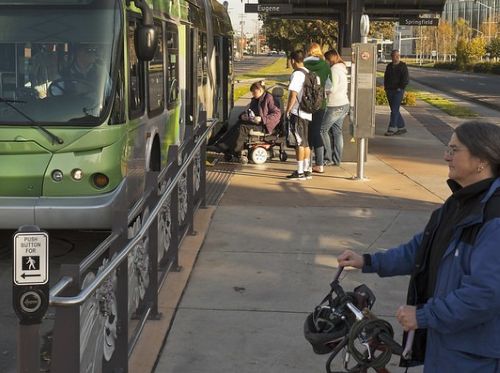FEDERAL ACTION
Biden administration launches website to help navigate extreme weather, other climate hazards – WHIO-TV
How Biden could help U.S. reach climate goals on his own – Washington Post
Empty Containers Will Overwhelm Ports in 2023 Warns Sea-Intelligence – Maritime Executive
Public Comment Mixed on FHWA’s Electric Charging Infrastructure Proposal – Transport Topics
A natural ally for climate resilience, disaster mitigation – The Hill (Opinion)
COVID-19
Public transit across the U.S. is not nearly as crowded as it was before the pandemic – NPR’s All Things Considered
Where You Still Need to Wear a Mask in New York City – New York Times
INFRASTRUCTURE RESILIENCE AND SUSTAINABILITY
NYSDOT Begins Roadway Flood Control Project – AASHTO Journal
States Play a Central Role in the EV Charger Buildout – Route Fifty
Universities’ research aims to make railroads climate resilient – FreightWaves
A New Tech Tool to Help Communities Confront Climate Risks – Route Fifty
FAA’s Largest Solar Project to Power Mike Monroney Aeronautical Center – FAA (Media release)
Columbia River port managers, Army engineers agree to $2.1 million study – US Army Corps of Engineers (Media release)
AIR QUALITY
Pittsburgh Regional Transit announces plan to transition to zero-emission bus fleet by 2045 – WPXI-TV
California Air Resources Board May Speed Fleet Electrification – Government Technology
United buys 200 electric air taxis from Embraer-backed Eve Air Mobility – Fox Business
Israel to Ban Boeing 747s, Other 4-Engine Planes Amid Environmental Concerns – U.S. News & World Report
ENVIRONMENTAL JUSTICE
Was the Climate Law a Win for Environmental Justice? It’s Complicated – Bloomberg
N.C. pushes for more EV charging stations in rural areas – Spectrum News 1
What are some unique transportation solutions in rural Indiana communities? – WFYI Radio
NACTO calls for US bicycle law reformation to decriminalize biking in cities – Cycling Weekly
NATURAL RESOURCES
Tennessee DOT Promoting Delta Region via New Partnership – AASHTO Journal
CULTURAL RESOURCES
Super Bowl visitors will swamp Sky Harbor Airport. Here’s what it’s doing to get ready – Arizona Republic
HEALTH AND HUMAN ENVIRONMENT/ACTIVE TRANSPORTATION
Washington Legislature Makes a Quantum Leap on Complete State Highways – The Urbanist
New app aims to keep drivers, cyclists and pedestrians safe on Cary roads – WRAL-TV
Residents push back on proposed Rockford, Illinois bike path expansion – Rockford Register Star
Free dinner? Free parking? Northern Virginia transportation leaders exploring creative options to incentivize commuter behavior – InsideNoVa
New Haven gets rolling on pedestrian, cycling and transit infrastructure – Yale Daily News
Boston Mayor, City Transportation Department Announce Expansion of Bike Network and Safer Streets – City of Boston (Media release)
WSDOT unveils new-look Statewide Human Services Transportation Plan – Washington State DOT (Media release)
TRB RESOURCES/ANNOUNCEMENTS
Advancing Low- and Zero-Emission Marine Vessel Technology Options Workshop – TRB (Link to workshop summary)
Microtransit – Innovation in Rural Mobility – TRB (Webinar)
Webinar: NCDOT Roadway Resiliency and Recovery – Roads & Bridges
FEDERAL REGISTER NOTICES
National Priorities List – EPA (Final rule)
Noise Exposure Map Notice: San Diego County Regional Airport Authority for San Diego International Airport – FAA (Notice of acceptance of a noise exposure map and review of a noise
compatibility program)
Noise Compatibility Program for Laredo International Airport, Webb County, Texas – FAA (Notice of acceptance of a noise exposure map)
Consolidated Port Approaches and International Entry and Departure Transit Areas Port Access Route Studies (PARS) Integral to Efficiency of Possible Atlantic Coast Fairways – Coast Guard (Notice of availability)


